The latest search frequency data is in from Wine-Searcher, and with it we can see which wines enjoyed the greatest popularity gains during July. After the en primeur campaign fuelled the big surges of May and June, July’s top five gainers witnessed more modest gains. There is also more variety this month, with two Champagnes and a Napa joining two Bordeaux right bank heavyweights.
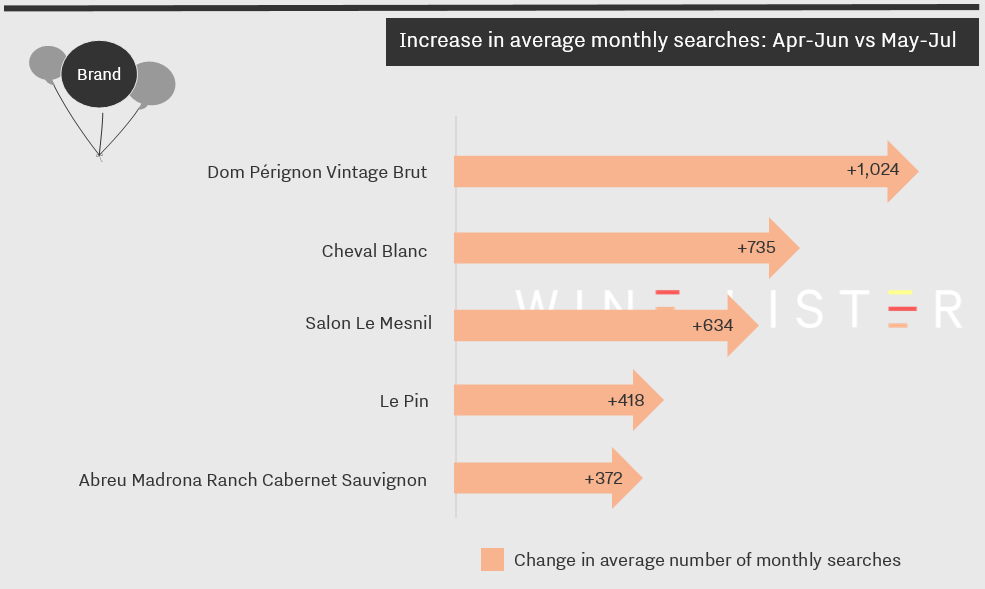
Experiencing the greatest increase in popularity during July was Dom Pérignon Vintage Brut – particularly impressive considering it started from an already extraordinarily strong average of over 54,000 searches each month.
Next came Cheval Blanc, whose 2016 vintage was released in early June, before July saw the release of Salon Le Mesnil 2006. Described by Wine Lister partner critic Antonio Galloni as an “utterly compelling Champagne to follow over the next several decades”, its rise in online popularity suggests that consumers have already started to track its progress.
The last two wines are both produced on very small scales. Le Pin, notoriously rare, released its 2016 vintage in late June, which likely contributed to its increase in online popularity, at least among those lucky few with both an allocation and requisite funds. About 6,000 bottles of Napa Valley’s Abreu Madrona Ranch Cabernet Sauvignon are produced each year. As we saw in our recent post on California’s most expensive wines, production levels play a big role in the region’s prices. Perhaps the rarity of Abreu Madrona, the region’s eighth most expensive wine, is helping to boost its caché.
A wine’s reputation for quality cannot be determined by one vintage alone – the very best must be consistent, year-in, year-out. Today, we’ve analysed our data to determine which wines have the most consistent Quality scores (one of the three categories, alongside Brand and Economics that feed into Wine Lister’s holistic wine ratings).
Assessing all the wines in our database for which there are Quality scores for more than 30 vintages, we analysed the standard deviation of these scores from vintage to vintage. The top 10 wines below are the most consistent when it comes to quality:
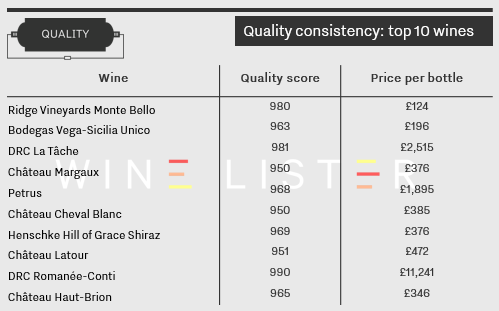
Unsurprisingly, these are all big names that have been able to invest in the newest technologies to see them through the more challenging years. Their reliability is testament to their status as great wines. Seven of the world’s top 10 most consistently qualitative wines are French, although of the five Bordeaux left bank first growths, only Margaux, Latour and Haut-Brion make the cut, joined by Petrus and Cheval Blanc from the right bank. Domaine de la Romanée-Conti is the only producer to boast two wines in the table: La Tâche and Romanée-Conti, also the two most expensive.
Perhaps unexpectedly, the most consistent wine is also the most affordable. At an average price per bottle of £124, Californian Ridge Vineyards Monte Bello sees limited fluctuation in Quality scores between the years, with the vast majority of vintages scoring between 960 and 990. It is followed by Spain’s Bodegas Vega-Sicilia Unico – whose Quality scores on Wine Lister stretch right back to its 1920 vintage, proving almost a century of consistent winemaking.
The latest trading data is in, and it is evident that this quarter one region’s wines have had particular success at auction. We’ve calculated which wines have seen the greatest incremental increases in bottles traded by using figures collated by Wine Market Journal from sales at the world’s major auction houses, looking at the total number of bottles sold of the top five vintages for each wine over the past four quarters.
In contrast to last quarter’s data, which saw wines from a variety of regions see trading volumes rise, all five wines in the table below are from Bordeaux. Four are from the left bank, with first growth Haut-Brion benefitting the most from increased trade, while right bank Ausone also makes the cut.
Latour is the only wine to feature two quarters running. This presents an interesting counterpoint to the château’s reported fall in trading volumes on the wine exchange Liv-ex. Since its decision in 2012 to withdraw from the en primeur system, Latour has held back its five most recent vintages. It seems unsurprising, therefore, that the wine is less present than its fellow first growths on trading platforms, where recent vintages tend to attract high volumes of trade. However, this has not affected the wine’s success on the auction market, which favours older vintages, and therefore arguably makes for a fairer comparison.
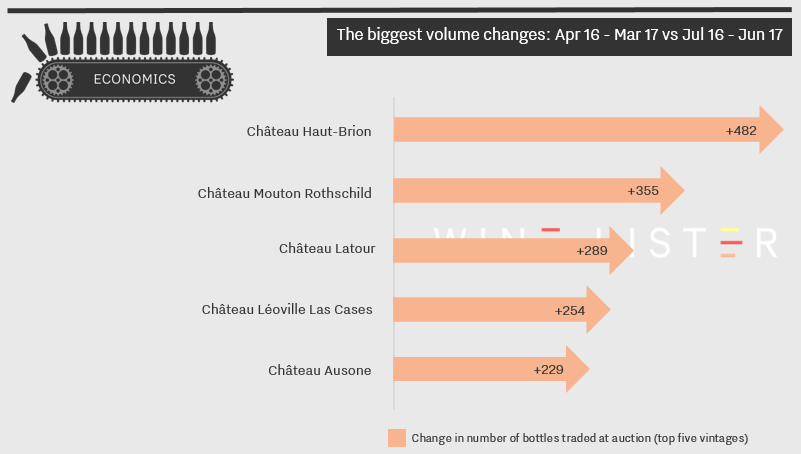
The latest online search frequency data is in from Wine-Searcher, and with it we can see which wines surged in popularity during June. As with May’s results, the effect of the 2016 en primeur campaign is evident, with four of the five spots filled by Bordeaux crus that released their 2016 vintage on or after 31st May.
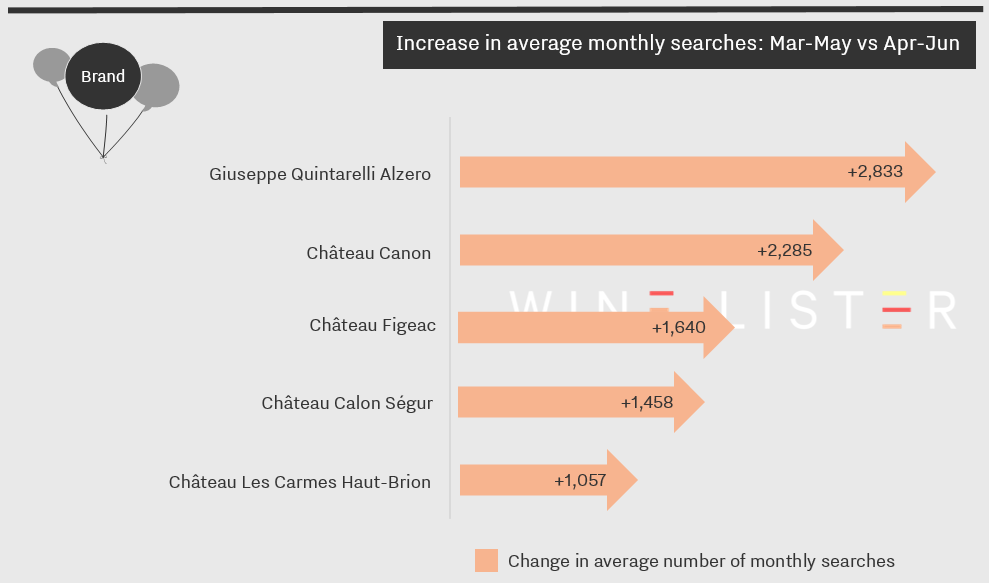
However, if the en primeur effect is to be expected, the likely reason for Giuseppe Quintarelli Alzero’s appearance at the top of the table could not have been foreseen. On 18th June, NBA star LeBron James posted a photo on Instagram of a bottle of Giuseppe Quintarelli Alzero 2007 that he was enjoying, having spent the day hosting his son’s birthday party. To date it has received well over 200,000 likes, surely contributing to its 168% increase in online search frequency. It appears that whilst La Place de Bordeaux is the fine wine world’s premier marketing machine, it is no match for LeBron James and his 31.8 million Instagram followers.
Returning to the en primeur effect, Canon 2016 was released at £73.35 per bottle on 1st June to great acclaim, having achieved its second-best Quality score ever. The leap in search frequency confirms its upward trajectory. Figeac repeats its May performance, surging even further in popularity in June. The 2016 vintage – Figeac’s best since 1989 – was released on 13th June, its 67% increase on the 2015 sterling release price signalling its clear intent to reposition itself.
Calon Ségur and Les Carmes Haut-Brion both comfortably achieved their best ever Quality scores with their 2016 offerings, and sold out quickly, no doubt prompting their surges in online search frequency during June. The next step is to get a famous sportsperson to post a photo of themselves drinking it.
Following on from our recent blog on the relationship between price and quality for seven leading wine regions, today we turn our attention to the role that brand strength plays on price for those same regions. The chart below compares the regions’ average three-month market price to their average Brand scores, using the same 50 overall top scoring wines in each region as in the previous post.
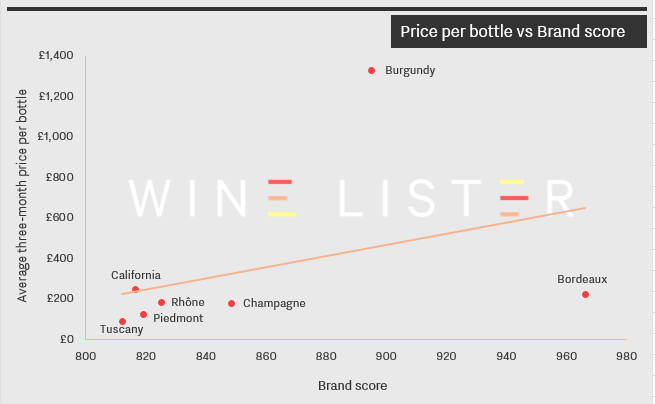
Bordeaux’s crus classés enjoy unassailable brand strength, a product of the success of the region’s classification system and the fact that its châteaux have enjoyed global renown for centuries. If you want brand for your buck, look no further.
Conversely, Burgundy’s extraordinary prices far exceed the level of brand clout commanded by its top crus. Its top wines trail the average Brand score of Bordeaux’s by 7%, but sell for nearly six times as much. This suggests that quality, and perhaps small production levels, play more of a part in the region’s prices.
The five remaining regions are more evenly matched. Tuscany’s wines have both the lowest average Brand score and the lowest prices, followed closely by Piedmont. Meanwhile California’s top 50 wines, which have the second-lowest average Brand score, command the second-highest prices. Top wines from the Rhône and Champagne command similar prices to their Bordeaux counterparts, but with average Brand scores more than 100 points lower.
In today’s blog, we’ve taken a look at the relationship between price and quality for seven leading wine regions. The chart below compares the regions’ average three-month market prices to their Quality scores, with the data calculated from each region’s 50 best-scoring wines (in terms of overall Wine Lister score).
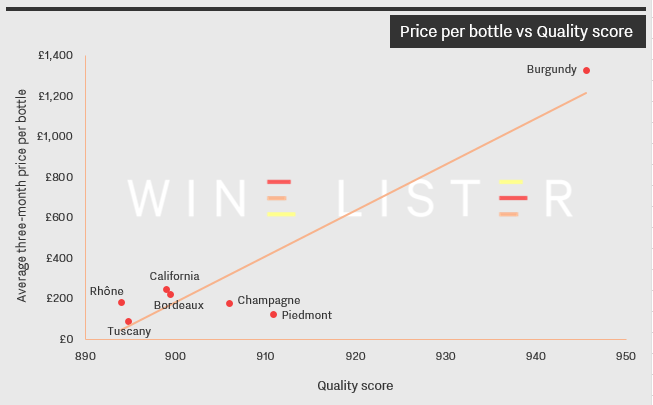
While six regions are clustered relatively close to each other, Burgundy finds itself at the extreme top end of the scale: its wines outperform on quality and have the prices to match. The top 50-scoring wines in Burgundy average a whopping £1,330 per bottle, driven by the likes of DRC La Romanée-Conti at £10,776 and Domaine Leroy Musigny at £7,805.
The Rhône’s wines have the lowest average Quality score but not the lowest prices: at £188 per bottle on average, they are the fourth most expensive of the group. California and Bordeaux display a very similar profile, appearing just above the trendline, indicating that these wines command high prices not simply on account of quality – brand also plays a part.
Champagne and Piedmont, meanwhile, fall below the line, suggesting that as regions they tend to offer value for money. Piedmont’s ranking is particularly impressive: second only to Burgundy in terms of average Quality score, its wines are available for a tenth of the price on average.
A couple of months ago we looked at which Bordeaux 2016s received the best Quality scores, calculated from scores given by our three renowned partner critics: Jancis Robinson, Antonio Galloni, and Bettane+Desseauve. Such quality comes with a price, however, and if the £430 per bottle for Lafleur (Quality score 990) is a little beyond your price range, then we hope this blog is useful. Below are the nine wines from the vintage which qualify as Wine Lister Value Picks.
None of the Value Picks was among the top 15 in our previous blog. Nevertheless, they all enjoy strong or very strong Quality scores on the Wine Lister scale. Fombrauge scores 898, and was described as “rather opulent” and “very successful” by Jancis Robinson. Available at just £16 per bottle, it represents excellent value for money.
Even the wine with the highest Quality score, sweet white Doisy-Daëne (899), is only £25. Those wishing to spend slightly less on a sweet white might also consider Filhot, which achieves a Quality score of 709, and is available at just £14 per bottle.
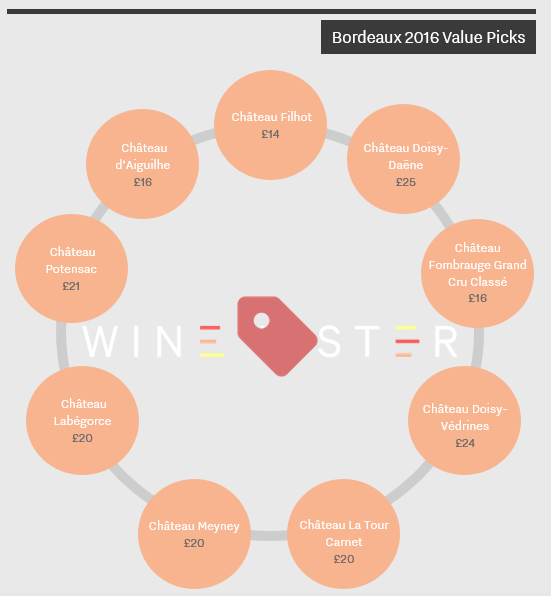
Please see our previous blog for further information on Wine Lister’s Value Picks.
Like Buzz Brands, which we explored last week, Value Picks are one of the four Wine Lister indicators, designed to highlight particularly interesting wines for our subscribers by isolating sub-sets of data. The Value Pick indicator helpfully identifies the wines and vintages which have the best quality to price ratio (with a proprietary weighting giving more importance to quality, thus allowing the finest wines a look-in).
This month, five of our eight new Value Picks are from France – but with a Sauternes, Riesling and left bank Bordeaux to choose from the options are still diverse. Most affordable is Domaine Cauhapé La Canopée Sec 2011, from Jurançon, at just £16 per bottle and with a Quality score of 733.
The most expensive wine – but still at only £34 per bottle – is one of the two Italians that feature this month: Elio Grasso Barolo Ginestra Vigna Casa Maté 2004, which has an exceptional Quality score of 971. The other wine in the table with a Quality score above 900 is Domaine Zind-Humbrecht Clos Windsbuhl Pinot Gris 2007, from Alsace, priced at under £30 and with a Quality score of 906.
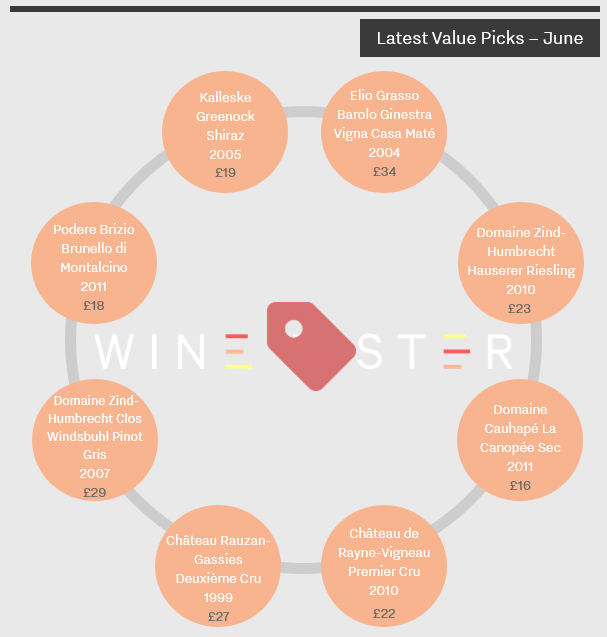
Please see our previous Value Pick blog for a note on prices.
What makes the perfect wine?
Using the entirety of a 1,000-point scale, Wine Lister’s scores are calculated using nine criteria that define iconic wines. These fall into the categories of Quality, Brand and Economics, giving a 360° view of the finest wines in the world.
Unlike wine critics’ scores, which sporadically feature a perfect 100/100, a perfect Wine Lister score of 1,000/1,000 is practically, though not theoretically, impossible. The perfect wine would have to be the best in the world across every single criterion – a magical combination of ingredients.
The perfect wine does not belong to any one region. In terms of quality, it has the perfect critic score of Sauterne’s unsurpassed Château d’Yquem (1), and the ageing potential of Cockburn’s Vintage Port (2). Its brand is legendary: like Dom Pérignon, it is found throughout the world’s top restaurants (3), and its online monthly searches rival those of Lafite (4).
The perfect wine outperforms on price. Already with a price per bottle to match that of Romanée-Conti (5), its vintages see price increases in both the short- (6) and long-term (7), without undue fluctuation (8). Finally, like Mouton, the perfect wine is traded in large volumes (9).
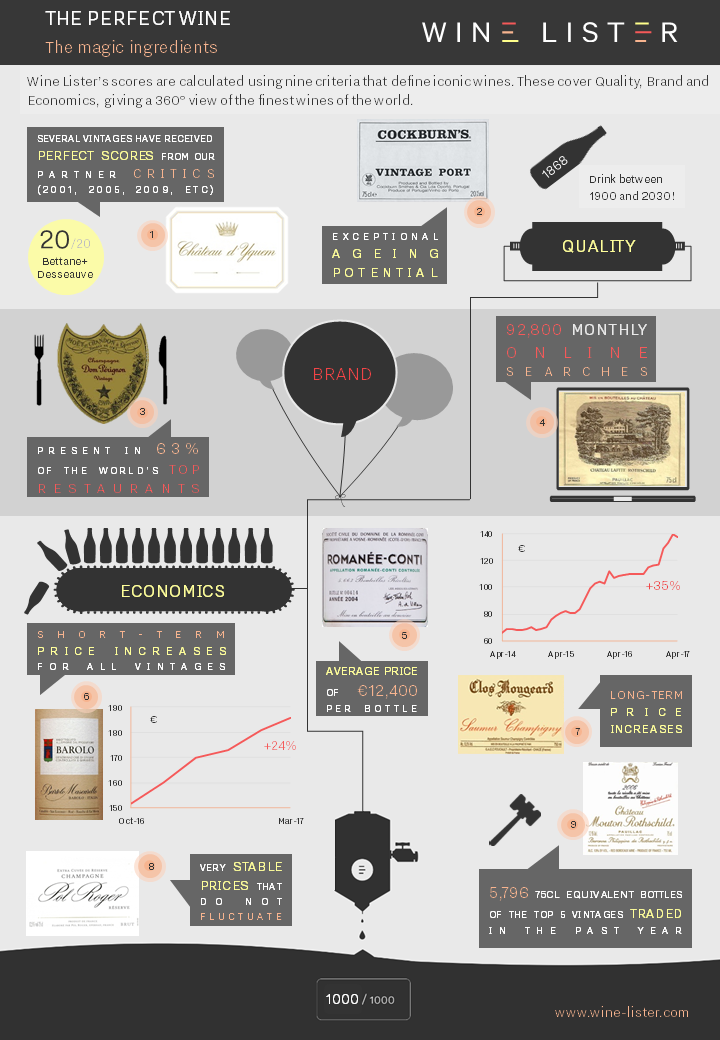
Download a PDF version here.
First published in French in En Magnum.
With the latest online search frequency data in from Wine-Searcher we can now see which wines caught the public’s attention in May. Results demonstrate the effect of the 2016 en primeur campaign – now coming to a close – with Bordeaux brands taking four of the five top spots.
Cos d’Estournel saw online searches rise the most last month: the brand was one of the first out of the blocks with its 2016 release, which came in late April, maintaining the same price as its 2015. Exactly one month later, Lynch-Bages released its 2016 for €96 ex-négociant. Despite a 14% increase on 2015, the release went down well on the Place de Bordeaux, perhaps due to the wine achieving the highest Quality score of the century.
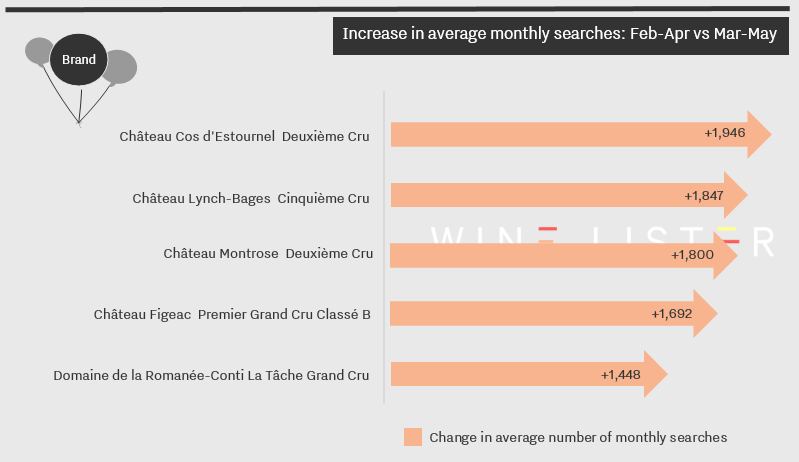
Montrose, which saw the third largest increase in searches in May, released its 2016 mid-month. With its Quality score up on 2009, 2010 and 2015, but, like neighbour Cos, releasing at the same price as 2015, Montrose 2016 looked like one of the vintage’s better buys. Figeac also saw searches soar in May but is something of an anomaly in this table – it only released its 2016 on Tuesday 13th June, too late to influence May’s search statistics. Nonetheless, the brand may well be garnering interest due to its exceptional Quality score, as rated by our three partner critics (Jancis Robinson in the UK, Bettane + Desseauve in France and Antonio Galloni in the US).
The final wine of the table, providing some respite from Bordeaux, is a heavyweight from Burgundy: DRC La Tâche. Two auctions in May – one from Sotheby’s and one from iDealwine – saw a number of bottles of La Tâche for sale, which may explain the boost in searches.









